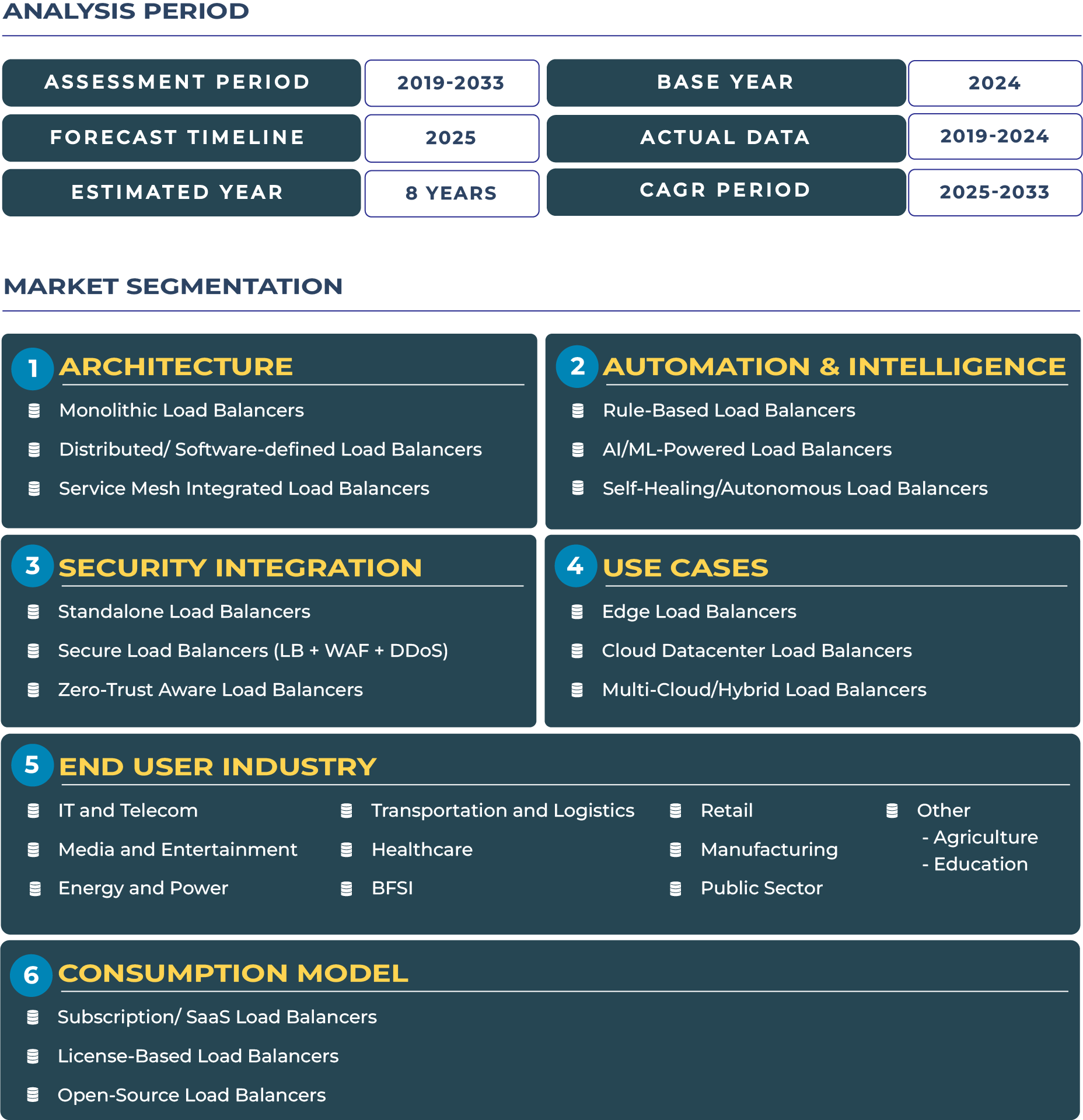Report Format:
![]()
![]() |
Pages: 110+
|
Pages: 110+
Philippines Cloud Load Balancers Market Outlook: BPO-driven Cloud Modernization Unlocks Digital Transformation
The Philippines cloud load balancers market is accelerating as the country embraces digital modernization, driven primarily by its robust BPO sector, SMEs, and the fast-growing fintech landscape. Known globally as a leader in business process outsourcing, the Philippines is rapidly deploying cloud load balancers to ensure application reliability, scalability, and performance across distributed workloads. Valued at USD 20.3 million in 2025, the market is forecasted to grow to USD 104.9 million by 2033, expanding at an impressive CAGR of 22.8%. This growth reflects the country’s pivot to cloud-native architectures, telco-led investments, and increasing demand for software-defined and service mesh integrated load balancing solutions.
The adoption journey is further reinforced by affordability-driven deployments, mobile-first consumer behavior, and the need for resilient digital infrastructure to support BPO modernization. As a result, the Philippines cloud load balancers industry is poised to become a critical enabler of long-term cloud transformation.
Reshaping Market Growth: Drivers and Restraints Defining the Philippines Cloud Load Balancers Landscape
The Philippines market is fueled by three pivotal growth drivers. First, the BPO and contact-center ecosystem, which employs millions, relies on high-availability digital infrastructure, making distributed and software-defined load balancers indispensable for operational continuity. Second, mobile-first consumers in the Philippines drive significant demand for digital services, requiring scalable backend systems supported by advanced load balancing. Third, the rapid adoption of fintech and remittance platforms has heightened the need for secure, high-performance application delivery.
However, the industry faces restraints that may slow adoption. Infrastructure reliability challenges, particularly power outages and uneven connectivity, create latency risks that hamper cloud operations. Additionally, price sensitivity among SMEs limits adoption of advanced solutions, pushing providers to innovate around affordable freemium models. Lastly, talent retention in advanced cloud roles remains a bottleneck, as skilled engineers often migrate to global markets. These dynamics create a delicate balance of opportunities and challenges for the Philippines cloud load balancers sector.
Emerging Trends and Opportunities Redefining the Philippines Cloud Load Balancers Industry
The Philippines cloud load balancers ecosystem is witnessing transformative trends. BPO cloud modernization is accelerating as global outsourcing firms demand enterprise-grade resiliency and efficiency from cloud infrastructure. At the same time, fintech and remittance applications, vital to the country’s remittance-heavy economy, are scaling aggressively, requiring distributed load balancer deployments to handle surges in traffic. Additionally, telco-edge PoPs are expanding, enabling lower latency and distributed routing efficiency in urban centers like Metro Manila and Cebu.
Opportunities lie in managed load balancing for BPOs, where predictable workloads create long-term partnerships. Telco partnerships also present a pathway for providers to bundle LB offerings into existing connectivity solutions, expanding customer reach. Furthermore, SMB SaaS packages with embedded load balancing create an entry point for small enterprises seeking cloud-native scalability. These opportunities indicate a thriving market for players ready to align with the country’s digital evolution.
Competitive Landscape: Strategic Partnerships and BPO-centric Cloud Load Balancing Expansion
The competitive landscape is shaped by a mix of international hyperscalers and local telco-driven collaborations. Global leaders such as F5 Networks and regional players collaborate with Philippine telcos to deliver software-defined load balancing and edge-integrated solutions. Key strategies include targeting BPOs with managed offerings, as these firms represent large, predictable customers whose infrastructure requirements drive scale. A notable development in 2024 was the increased collaboration between telcos and cloud-native providers to deploy freemium-based load balancing solutions, enabling startups and SMEs to test, adopt, and scale at lower costs.
As the Philippines cloud load balancers landscape matures, competition will hinge on how effectively providers integrate managed services into BPO contracts, address price sensitivity, and support fintech applications with scalable cloud-native delivery models. This evolving dynamic will determine the success of market players in the coming decade.







